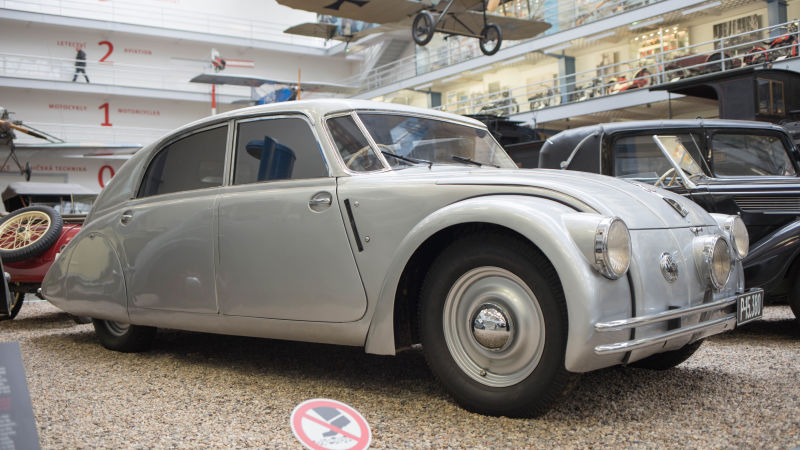
About a month ago, I went on vacation in Prague and paid a visit to the very lovely National Technical Museum. It’s awesome and definitely worth a visit. Because if you do go, you’ll see a sleek, silver 1937 Tatra 77a parked on the ground floor, which I later learned was actually shockingly good at killing Nazis during World War II. Here’s why.
In 1934, Czech vehicle manufacturer Tatra—a company led by legendary engineer Hans Ledwinka—launched the first serially produced, aerodynamically designed car called the T77. It was streamlined and sleek, with a body shaped in a wind tunnel and a freaking fin on its back, like some glossy fish car from the future. It was partly designed by Paul Jaray, the engineer behind the aerodynamics of the Zeppelin.
Advertisement
Since the T77 needed to be as aerodynamic as possible, Tatra minimized the T77’s front face area and stuck the engine—a 2.97-liter air-cooled V8, good for 59 horsepower—in the back, right above the rear axle. This allowed the car to reach speeds of 90 mph, which were considered extremely fast in those pre-war days.
Advertisement
In 1935, the T77 was improved to create its successor, the 77a. The displacement of the V8 was increased to 3.4 liters and power jumped to 70 HP, with a top speed of 93 mph. The cars were among the most advanced and high-tech of their time.
Underneath their flashy hides, the T77 and 77a both had four-wheel independent suspension that used swing axles in the back and a transverse leaf spring system in the front, writes Hemmings.
Stunning as they were to look at, though, the T77 and the 77a were harrowing to drive. Thanks to an extreme rear weight bias and long wheelbase, the T77 and 77a were said to have acutely twitchy handling. It would be altogether too simple to overcook a corner and have the heavy ass swing out into dangerous oversteer. Tire technology from the 1930s probably didn’t do it any favors, either.
Advertisement
The German occupation of Czechoslovakia lasted from 1938 to 1945. The stylish and fast Tatras were very appealing to the Nazis and rose in popularity with high-ranking SS officers, British writer Steve Cole told the Telegraph. And you can totally see why: When you bully your way into a country, you want to take the nicest shit for yourself. Textbook invaders, the lot of them.
Trouble rose when those Nazi officers tried to go fast in their new cars, though. A bunch of them kept crashing and dying.
Advertisement
Per Cole:
“These high-ranking Nazi officers drove this car fast but unfortunately the handling was rubbish, so at a sharp turn they would lose control, spin out and wrap themselves round a tree killing the driver more often than not. The Allies referred to the Tatra cars as their secret weapon against the Nazis.
“More high-ranking Nazi officers were killed in car crashes in the Tatra 77 [and 87] than were killed in active combat. It goes to show that being too flashy doesn’t get you anywhere and will leave you dead.”
Advertisement
Savage, but probably not something the Czechoslovakians were too broken up about.
Eventually, though, Tatra was able to improve the handling of the 77a’s successor, the T87. Its engineers shortened the wheelbase by 12 inches and cast its engine from a lightweight alloy, according to Hemmings. The resulting car was nearly 900 pounds lighter than the outgoing model.
Advertisement
The National Technical Museum’s placard beside the 77a doesn’t mention any of its Nazi-killing prowess, but now you know and you can impress your friends and relatives the next time you pay it a visit.













